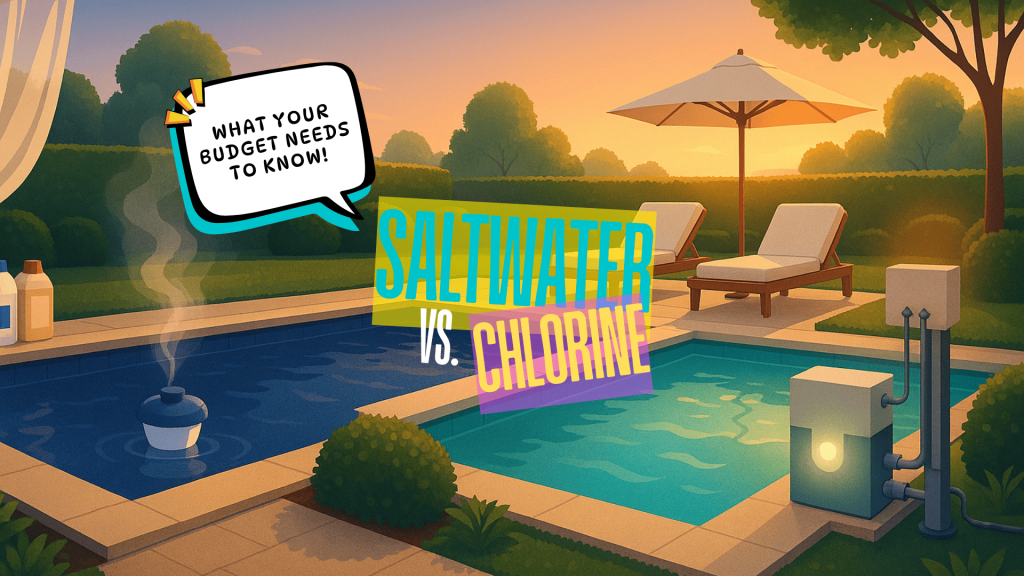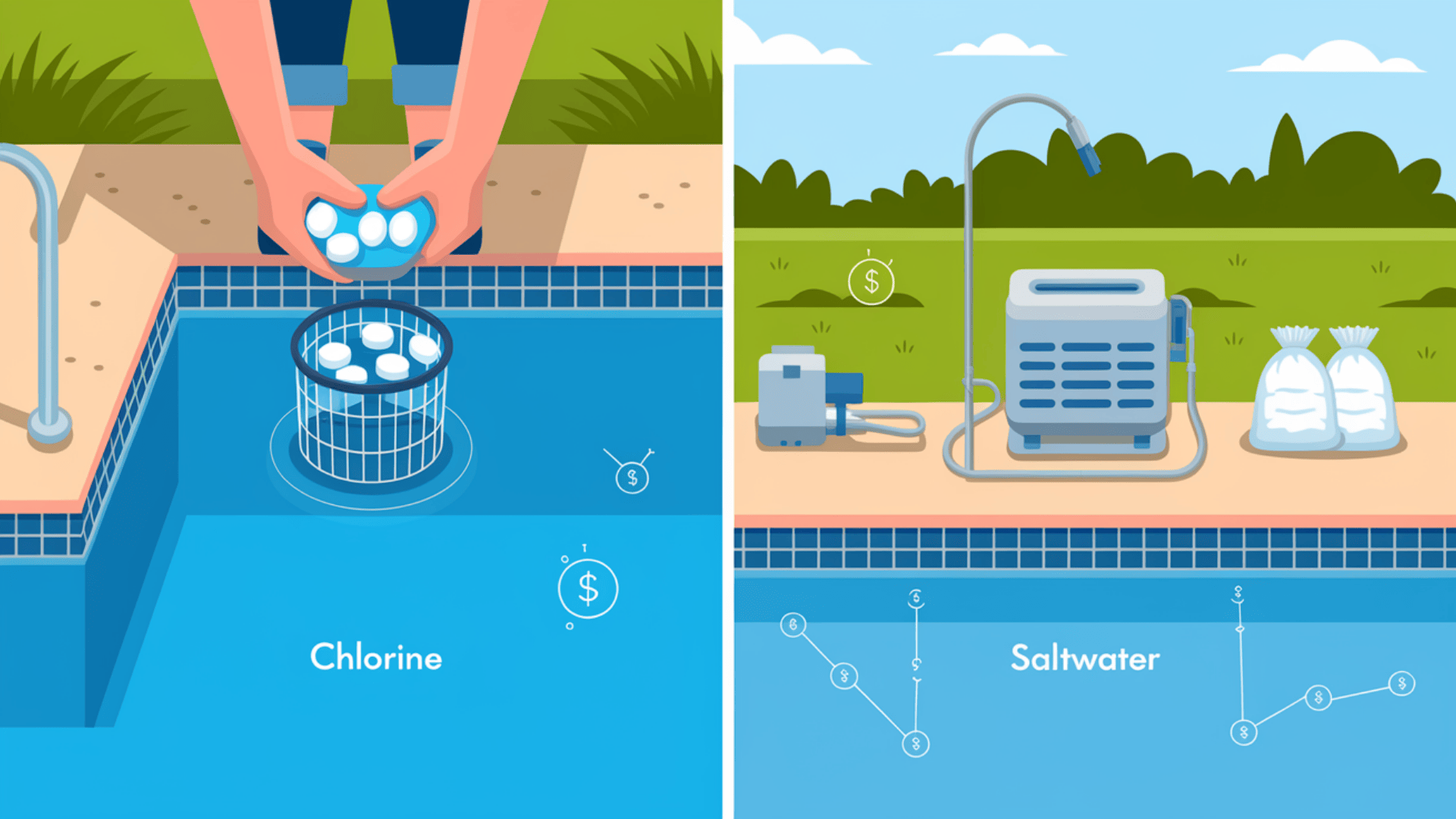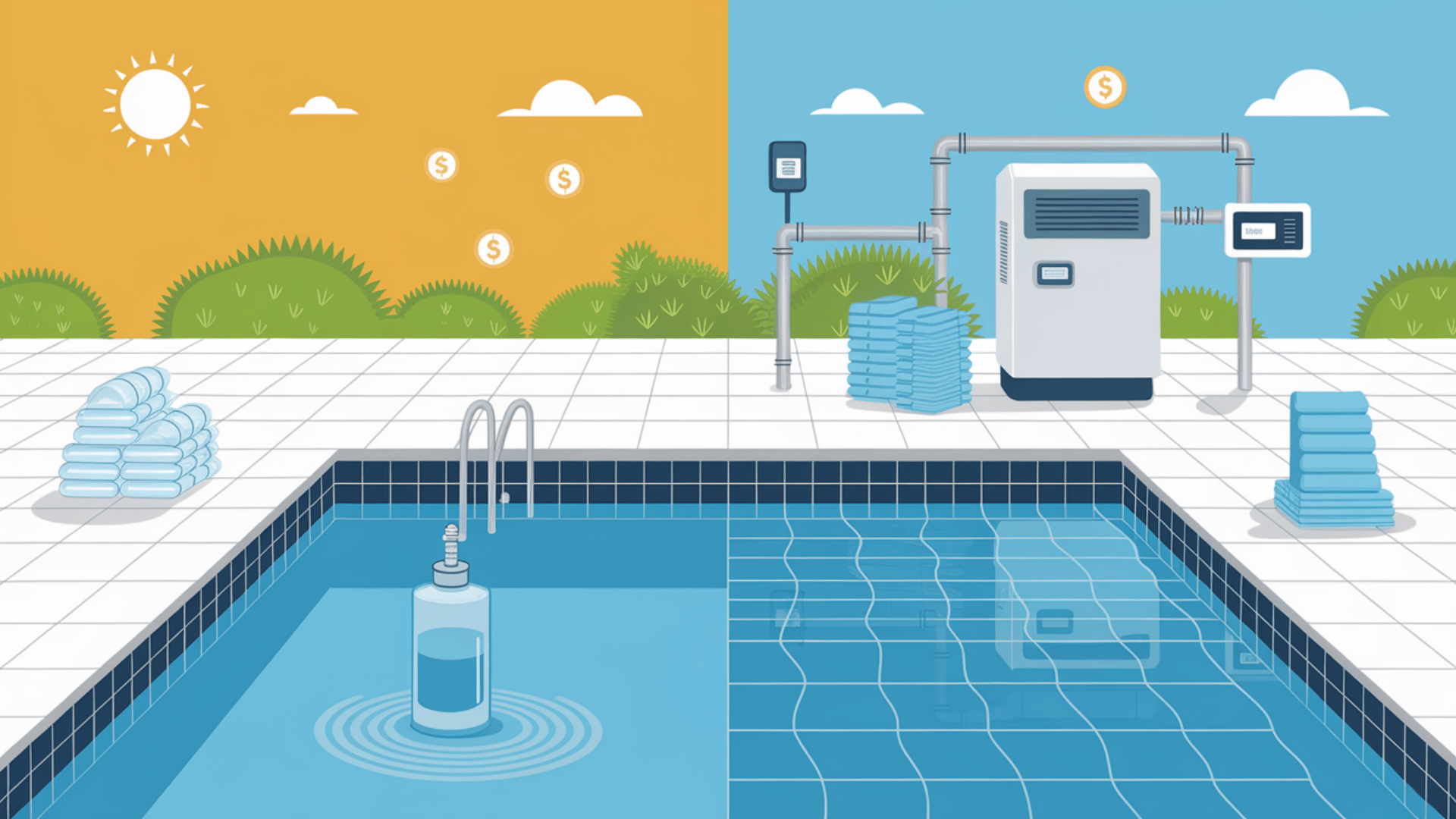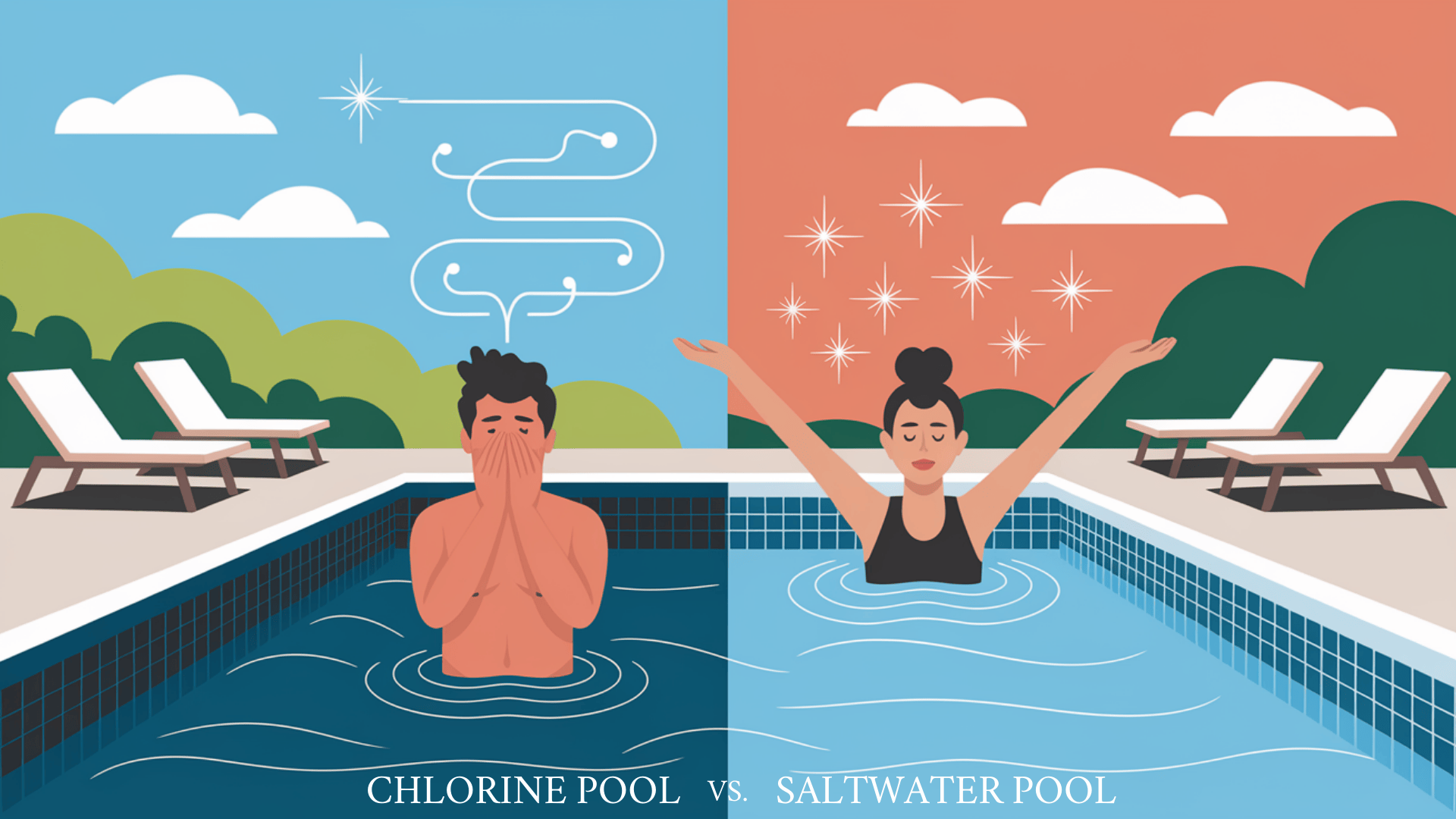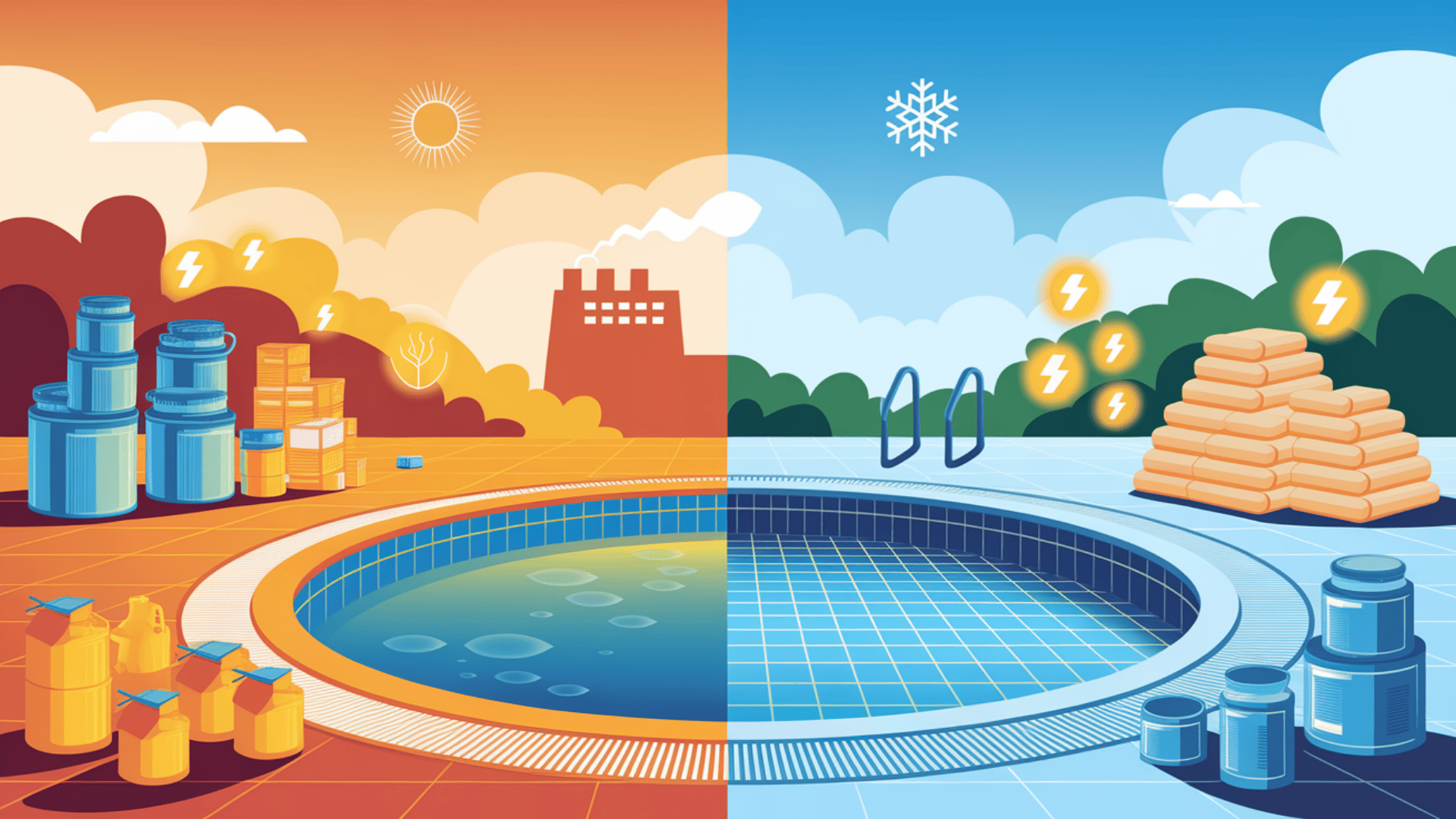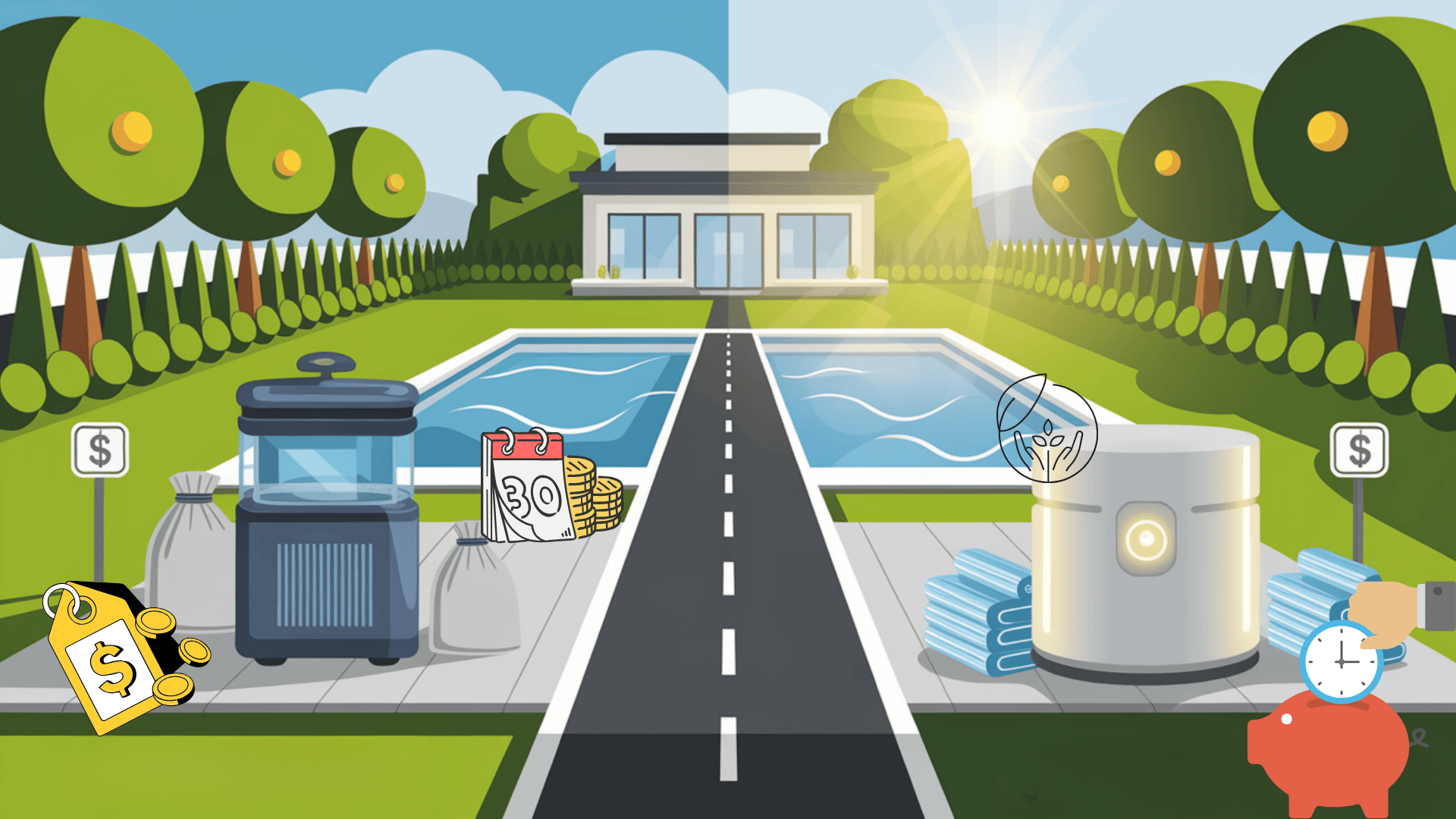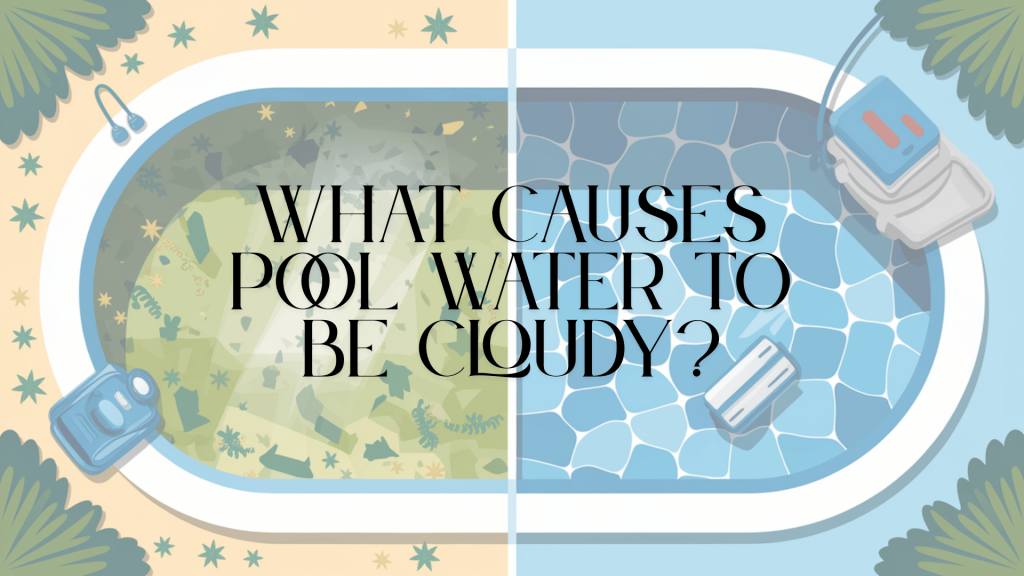Thinking about a backyard pool? Your wallet needs to know: salt or chlorine? The debate goes beyond just how the water feels.
While saltwater pools have surged in popularity, the true cost comparison isn’t as simple as the sales pitches suggest. Upfront expenses, yearly maintenance, and long-term ownership all tell different stories.
Many new pool owners are surprised by unexpected costs that weren’t mentioned during the installation discussions. Ready to swim through the real numbers?
Let’s break down exactly what you’ll pay for each system – from day one through year ten – so you can make the choice that keeps both your pool and bank account crystal clear.
Understanding the Basic Cost Differences
Swimming pools are equipped with two primary sanitizing methods: traditional chlorine systems and salt systems. These differ in the amount of cash you’ll need upfront and over time.
With chlorine pools, you’ll spend less to get started—the basic equipment costs between $300-$500, which saves you money right now.
However, you’ll continue to purchase chlorine tablets or liquid regularly, at a cost of approximately $400-$800 per year, depending on your pool size and local prices.
Salt systems flip this pattern. You’ll pay more upfront, approximately $1,000-$1,500 for the salt cell generator and installation. But your yearly costs drop significantly to around $100-$300 for salt and occasional cell cleaning.
For tight budgets right now, chlorine makes sense. For long-term savings, salt systems usually win out. Your choice may depend on whether you can afford higher costs today for the sake of savings tomorrow.
How Saltwater and Chlorine Pool Systems Actually Work
Many pool owners think these systems work in completely different ways, but the truth might shock you. Both systems use chlorine to clean your pool – they just make it differently.
In a standard chlorine pool, chlorine is added directly through tablets, liquid, or granules. You add these to your pool regularly, and they kill bacteria and other unwanted substances in your water. It works quickly but requires ongoing attention from you.
Saltwater pools work more behind the scenes. They use a generator that turns regular salt into chlorine through a process called electrolysis.
Your pool water passes through a cell that has electricity running through it. This process removes the salt (NaCl) and converts it into chlorine directly within your water system.
The big mistake people make is thinking saltwater pools don’t use chlorine. They do! The levels are just lower and more steady.
Initial Installation Costs Breakdown
Setting up your pool with either system incurs different upfront costs that you should be aware of before making a decision.
The main expense with saltwater systems is the chlorine generator itself. This piece of equipment typically costs between $500 and $2,000, depending on your pool size and the brand’s quality. Then add installation labor, which costs $200-$500 if you hire a professional to do it correctly.
Standard chlorine systems are more cost-effective to start, typically costing just the price of a chlorine feeder or floating dispenser ($25-$100) plus your initial chemical package ($50-$150).
Your pool material matters too. Concrete pools work well with either system. Vinyl liner pools require careful setup with saltwater, as the metal parts may corrode more quickly. Fiberglass pools are a perfect match for salt systems, as they naturally resist corrosion.
Extra Equipment Needs
When setting up a saltwater pool system, there are more factors to consider than just the generator. The saltwater environment creates specific demands on your pool equipment that standard setups might not be ready to handle.
Most pool installers recommend upgrading several key components when switching to salt. The slightly corrosive nature of salt requires the use of more durable materials throughout your system.
These upgrades aren’t optional extras – they’re essential investments that protect your pool’s infrastructure.
- More robust pool pump ($200-$400)
- Better filtration systems ($100-$300)
- Zinc anodes to protect metal parts ($20-$50 each)
- Salt ($50-$100 for initial filling)
All these costs add up at the beginning but pay off later in easier care and fewer ongoing expenses.
Many homeowners also install flow switches and salt level monitors to protect their investment. These safety features shut off the chlorine generator when water flow is too low or when salt levels fall outside the optimal range.
Long-term Maintenance Cost Comparison
After your pool is up and running, the real cost story begins to unfold over years of ownership. Traditional chlorine pools require ongoing chemical purchases: $50-$100 monthly for chlorine during swim season, plus $200-$400 yearly for pH adjusters, algaecides, and shock treatments.
Saltwater pools cost much less for chemicals – just $20-$50 yearly for salt to replace what’s lost from splashing and backwashing. The water stays balanced longer, reducing other chemical needs.
The main expense for saltwater systems is replacing the salt cell every 3-7 years at $300-$700. Salt systems also use slightly more electricity, adding $30-$50 to your seasonal power bill.
Time investment tells another story: chlorine pools demand weekly testing and chemical additions (1-2 hours weekly), while saltwater pools mostly run themselves with checks every 2-3 weeks, saving you valuable time.
Five-Year Cost Breakdown
Understanding how these costs play out over time helps you make a smarter choice for your budget. The table below shows what most pool owners can expect to spend over five years with each system for a standard 15,000-gallon pool:
| EXPENSE CATEGORY | TRADITIONAL CHLORINE POOL | SALTWATER POOL |
|---|---|---|
| Initial setup | $50-$150 | $1,500-$2,500 |
| Yearly chemicals | $600-$900 | $50-$100 |
| Five-year chemical total | $3,000-$4,500 | $250-$500 |
| Equipment replacement | $100-$200 | $300-$700 (once) |
| Extra electricity | $0 | $150-$250 |
| Estimated time cost (5 yrs) | 250-300 hours | 60-100 hours |
Many families find that saltwater systems break even around year three of ownership. From that point forward, the savings continue to grow.
The value of your time saved on maintenance isn’t included in the dollar figures but represents a significant quality-of-life improvement that many pool owners cite as the deciding factor in their choice.
Health, Comfort, and User Experience Factors
The feeling of your pool water significantly impacts your swimming enjoyment, often outweighing pure cost considerations.
Standard chlorine pools typically leave swimmers with dry, itchy skin and red eyes. Many notice the strong chemical smell and experience discomfort after extended swimming sessions.
Saltwater pools provide a distinctly different experience. Most users report softer-feeling water that’s gentler on skin, eyes, hair, and swimwear. The salt concentration (about 3,000 ppm) is barely noticeable compared to ocean water (35,000 ppm).
1. Skin and Eye Comfort
Chlorine pools often cause dry, itchy skin after swimming. The changing chlorine levels can strip natural oils from your skin and hair, leaving them feeling brittle and damaged. Many swimmers need to shower immediately and apply moisturizer to combat these effects.
Saltwater systems maintain steady, lower chlorine levels that are much gentler on your body. The water feels smoother and silkier against your skin.
Many swimmers report less dryness, reduced itching, and healthier-looking hair after switching to saltwater pools. Children especially benefit from this gentler approach, experiencing fewer skin irritations during summer swimming sessions.
2. Respiratory Benefits
The strong chemical smell around traditional chlorine pools isn’t just unpleasant—it can trigger breathing problems for sensitive individuals. This odor comes from chloramines, compounds formed when chlorine reacts with contaminants.
Saltwater pools produce fewer chloramines thanks to their continuous low-level chlorination process. This results in better air quality around the pool area, making breathing easier for everyone. People with asthma, allergies, or other respiratory conditions often report significant improvement in symptoms when swimming in saltwater systems.
Many families choose saltwater specifically for these health benefits, finding that family members with sensitivities can enjoy swimming again without respiratory flare-ups or medication.
3. Overall Swimming Experience
The total experience in each pool type differs noticeably. In traditional chlorine pools, swimmers often deal with:
| FACTOR | TRADITIONAL CHLORINE POOL | SALTWATER POOL |
|---|---|---|
| Swimwear durability | Faster fading and breakdown | Extended swimsuit life |
| Underwater visibility | Can cause stinging, bloodshot eyes | Comfortable underwater vision |
| Odor retention | Chemical smell lingers on skin and hair | No harsh chemical odors |
| Swimming consistency | Occasional restrictions during shocking | Consistent water quality year-round |
| Time in the pool | Often shorter swimming sessions | Longer, more frequent swimming reported |
This enhanced experience leads many pool owners to report longer, more frequent swimming sessions after converting to saltwater systems.
Environmental Impact and Additional Considerations
Your pool choice affects more than just your backyard – it has wider impacts worth thinking about.
Traditional chlorine pools require the manufacturing, packaging, and shipping of chemicals regularly. This creates a larger carbon footprint over time. The production process for these chemicals also uses resources and energy.
Saltwater systems use much less packaged chemicals, cutting down on plastic waste and transportation impact. Salt is a natural resource that needs minimal processing.
Water use differs slightly, too. Chlorine pools sometimes require more frequent draining and refilling when it becomes difficult to balance the chemical levels. This wastes water and the energy used to heat it.
Weather Factors
Your local climate plays a big role in your decision:
In very hot places like Phoenix or Las Vegas, chlorine breaks down faster in sunlight, meaning you’ll use more. Salt systems excel here since they continuously produce fresh chlorine.
Cold climates present challenges for salt systems, which might need to be shut down during freezing weather to protect the cell.
Rainy areas dilute pool chemicals faster, requiring more additions for chlorine pools. Salt systems adjust automatically as water passes through the generator.
Making the Right Choice for Your Situation
With all these factors to weigh, your final decision should match your specific needs and situation.
For homes where the pool gets used daily by many people, saltwater often makes more sense. The steady sanitizing and lower maintenance match high-use pools perfectly.
Rental properties present an interesting case. While saltwater systems mean less work for tenants (who might not maintain a pool properly), the equipment is more expensive to replace if damaged. Many landlords stick with simpler chlorine systems for this reason.
Budget Timing
Consider when you can best afford costs:
- Tight budget now, but stable income? Choose chlorine first, convert later
- Can handle upfront costs? Saltwater saves money long-term
- Planning to sell soon? Saltwater pools can be a selling point
- Uncertain about commitment? Start with chlorine, which requires less investment.
Converting from chlorine to salt costs $1,000 to $2,500, depending on the pool size. Going the other way is much cheaper – just stop using the salt cell and start adding chlorine.
The most important factor might not be cost at all, but how much you value your time. Chlorine pools require regular attention, whereas salt systems generally maintain themselves with occasional oversight.
Wrapping It Up
Considering the complete picture, saltwater systems generally prevail in the long-term cost battle, despite higher startup expenses. Most owners reach their break-even point around year three.
Beyond the financial benefits, the value of reduced maintenance time and a more comfortable swimming experience might tip your decision.
Consider your specific situation: how often you’ll use the pool, your local climate, and how long you’ll be staying in your home.
The perfect choice balances your current budget with future savings goals. Regardless of which system you choose, proper maintenance remains the key to keeping any pool affordable.
Now you can dive into pool ownership with confidence, knowing exactly what costs await beneath the surface.
Share Your Experience: Do you already own a pool? Tell us your actual costs and what you wish you’d known before choosing your system! Your insights help future pool owners.

